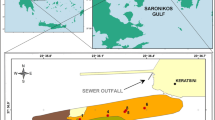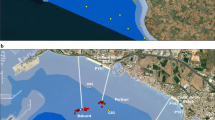Abstract
The Tinto and Odiel rivers drain 100 km from the Rio Tinto sulphide mining district, and join at a 20-km long estuary entering the Atlantic Ocean. A reconnaissance study of heavy metal anomalies in channel sand and overbank mud of the river and estuary by semi-quantitative emission dc-arc spectrographic analysis shows the following upstream to downstream ranges in ppm (μg g−1): As 3,000 to <200, Cd 30 to <0.1, Cu 1,500 to 10, Pb 2,000 to <10, Sb 3000 to <150, and Zn 3,000 to <200. Organic-rich (1.3–2.6% total organic carbon, TOC), sandysilty overbank clay has been analyzed to represent suspended load materials. The high content of heavy metals in the overbank clay throughout the river and estuary systems indicates the importance of suspended sediment transport for dispersing heavy metals from natural erosion and anthropogenic mining activities of the sulfide deposit. The organic-poor (0.21–0.37% TOC) river bed sand has been analyzed to represent bedload transport of naturally-occurring sulfide minerals. The sand has high concentrations of metals upstream but these decrease an order of magnitude in the lower estuary. Although heavy metal contamination of estuary mouth beach sand has been diluted to background levels estuary mud exhibits increased contamination apparently related to finer grain size, higher organic carbon content, precipitation of river-borne dissolved solids, and input of anthropogenic heavy metals from industrial sources. The contaminated estuary mud disperses to the inner shelf mud belt and offshore suspended sediment, which exhibit metal anomalies from natural erosion and mining of upstream Rio Tinto sulphide lode sources (Pb, Cu, Zn) and industrial activities within the estuary (Fe, Cr, Ti). Because heavy metal contamination of Tinto-Odiel river sediment reaches or exceeds the highest levels encountered in other river sediments of Spain and Europe, a detailed analysis of metals in water and suspended sediment throughout the system, and epidemiological analysis of heavy metal effects in humans is appropriate.
Similar content being viewed by others
Literature Cited
Aston, S. R. andI. Thornton. 1977. Regional geochemical data in relation to seasonal variations in water quality.Science of the Total Environment 7:247–260.
Badham, J. P. N. 1982. Further data on the formation of ores at Rio Tinto, Spain.Transactions of the Institute of Mining and Metallurgy (Section B: Applied Earth Science) 91:B26-B32.
Burke, K. andF. J. Sawkins. 1977. Were the Rammelsberg, Meggen, Rio Tinto and related ore deposits formed in a Devonian rifting event?.Geological Society of America Abstracts With Programs 9:916.
Forstner, U. 1983. Chapter 13—Assessment of metal pollution in rivers and estuaries, p. 395–428.In I. Thornton (ed.), Applied Environmental Geochemistry. Academic Press, London.
Forstner, U. andG. T. W. Wittmann. 1981. Metal Pollution in the Aquatic Environment. Springer-Verlag, New York. 486 p.
Fournier, A. M., J. M. G. Debustos, I. A. Gonzalez, J. R. Ruiz, A. M. N. Conesa, I. V. Fernandez, andA. M. Sans Martin. 1986. Metales pesados en sedimentos, agua y vegetacion del Rio Ebro, p. 347–356.In M. Mañino, (ed.), El Sistema Integrado del Ebro: Cuenca, Delta y Medio Marino. Gráficas, Hermes, Madrid.
Garcia-Vargas, M., F. Cordon, M. A. Guerrero, andR. Coy III. 1979. Evaluacion Preliminar de la Contaminacion por Metales Pesados en el Estuario del Rio Tinto.Tecnica Investigacion Tratamiento Medio Ambiente 1:59–68.
Garcia-Vargas, M., M. T. Ruiz-Abrio, andM. A. Guerrero. 1980. Determinación de metales pesados por espectroscopia de absorción atómica en la cuenca del río Tinto.Tecnica Investigacion Tratamiento Medio Ambiente 2:12–24.
Gardner, J. V., W. E. Dean, andB. Alonso. 1990. Inorganic geochemistry of surface sediments of the Ebro shelf and slope, northwestern Mediterranean.Marine Geology 95:225–245.
Giro, S. andA. Maldonado. 1985. Análisis granulométrico por métodos automáticos: Tubo de sedimentacion y sedigraph.Acta Geologica Hispanica 20:95–102.
Golightly, D. W., A. F. Dorrzapf, R. E. Mays, T. F. Fries, andN. M. Conklin. 1987. Analysis of geological materials by direct-current arc emission spectrography and spectrometry.United States Geological Survey, Bulletin 1770:A1-A13.
Gomez-Parra, A., R. Establier, andD. Escolar 1984. Heavy metals in recent sediments from the Bay of Cadiz, Spain.Marine Pollution Bulletin 15:307–310.
Govindaraju, K. 1989. Compilation of working values and sample descriptions for 272 geostandards.Geostandards Newsletter 13:1–113.
Hildebrand, S. G., S. A. Janzen, J. W. Huckabee, J. A. Solomon, F. S. Diaz, and K. D. Kumar. 1980. Distribution of mercury in the environment at Almaden, Spain. Oak Ridge National Laboratory (ORNL)-Environmental Sciences Division, Publication no. 1570, Oak Ridge, Tennessee. 88 p.
Instituto Geologico y Minero de Espana. 1974. Investigacion Minera Submarina en el Subsector “Huelva l” Golfo de Cadiz. Servicio de Publicationes Ministerio de Industria. Madrid. 89 p.
Johnson, C. A. 1986. The regulation of trace element concentrations in rivers and estuarine waters contaminated with acid mine drainage: The adsorption of Cu and Zn on amorphous Fe oxyhydroxides.Geochimica et Cosmochimica Acta 50: 2433–2438.
Levinson, A. A. 1974. Introduction to Exploration Geochemistry. Applied Publishing Limited Wilmette Illinois. 924 p.
Maldonado, A. andB. Alonso. 1983. Concentraciones de metales pesados y mecanismos de dispersión en tres sectores de la plataforma continental del Mediterráneo Espana, p. 120–136.In J. C. Piulachs (ed.), Estudio Oceangrafico De La Plataforma Continental, Proyecto De Investigación Cooperativa Hispano-Norteamerica, Gráficas Buper, S.A., Barcelona.
Mattigod, S. V. andA. L. Page. 1983. Assessment of metal pollution in soils, p. 357–394.In I. Thornton (ed.), Applied Environmental Geochemistry. Academic Press, New York.
Nelson, C. H. 1970. Potential development of heavy metal resources in the northern Bering Sea, p. 366–367.In Proceedings of the 20th Science Conference in Alaska, 1969. Alaska Division American Association for Advancement of Science, Fairbanks, Alaska.
Nelson, C. H. 1971. Northern Bering Sea, a model for depositional history for Arctic shelf placers, ecological impact of placer development, p. 246–254.In Proceedings, First International Conference on Port and Ocean Engineering under Arctic Conditions, Technical University of Norway, Trondeim.
Nelson, C. H. and D. M. Hopkins 1972. Sedimentary processes and distribution of particulate gold in the nothern Bering Sea. United States Geological Survey Professional Paper 689. 26 p.
Nelson, C. H., B. R. Larsen, E. A. Jenne, andD. H. Sorg. 1977. Mercury dispersal from lode sources in the Kuskokwim River drainage, Alaska.Science 1198:820–824.
Nelson, C. H., D. W. Pierce, K. W. Leong, andF. W. Wang. 1975. Mercury distribution in ancient and modern sediments of the northeastern Bering Sea.Marine Geology 18:91–104.
Palanques, A. andJ. I. Diaz. 1990. Heavy metal pollution in the surface sediments of the Barcelona continental shelf (northwestern Mediterranean).Revista de la Sociedad Geológica de España 3:357–371.
Palanques, A., F. Plana, M. Baucells, G. Lacort, andM. Roura. 1989. Determination of heavy metal pollution by ICP and AAS in the suspended matter of the Gulf of Cadiz.International Journal of Environmental Analytical Chemistry 36: 85–93.
Palanques, A., F. Plana, andA. Maldonado. 1990. Recent influence of man on the Ebro margin sedimentation system, northwestern Mediterranean SeaMarine Geology 95:247–263.
Poss, J. R. 1978. Rio Tinto-treasure of the ages: Mining from 100 B.C. to present,World Mining September, 1978:137–139.
Rodier, J. 1976. L’analyse de l’eau. Ed. Dunod, Paris. 560 p.
Schermerhorn, L. J. G. 1982. Framework and evolution of Hercynian mineralization in the Iberian Meseta.Comunicacione Geologica Iceo, Portugal, t. 68, fasc. 1:91–140.
Stenner, R. D. andG. Nickless. 1975. Heavy metals in organisms of the Atlantic Coast of Southwestern Spain and Portugal.Marine Pollution Bulletin 6:89–92.
United States Army Topographic Command. undated. Sheet NJ 29-9, Series 1501, Edition 1, map Stock, No. 1501XNJ299, United States Department of Defense, Washington D.C. 1 p.
van Geen, A., E. A. Boyle, andW. S. Moore. 1991. Trace metal enrichments in waters of the Gulf of Cadiz, Spain,Geochimica et Cosmochimica Acta 55:2173–2191.
Williams, D. 1942. Rio Tinto, Spain, p. 258–262.In W. H. Newhouse (ed.), Ore Deposits as Related to Structural Features. Princeton University Press, Princeton, New Jersey.
Williams, D., R. L. Stanton, andF. Rambaud. 1975. The Planes-San Antonio pyritic deposit of Rio Tinto, Spain: Its nature, environment and genesis.Transactions of the Institute of Mining and Metallurgy (Section B: Applied Earth Science) 84: B73-B82.
Wilson, A. J. 1981. Archaeologists find “Missing Link” in Rio Tinto Mining History.Queensland Government Mining Journal 32–33.
Author information
Authors and Affiliations
Rights and permissions
About this article
Cite this article
Nelson, C.H., Lamothe, P.J. Heavy metal anomalies in the Tinto and Odiel River and estuary system, Spain. Estuaries 16, 496–511 (1993). https://doi.org/10.2307/1352597
Received:
Accepted:
Issue Date:
DOI: https://doi.org/10.2307/1352597




